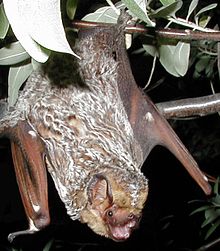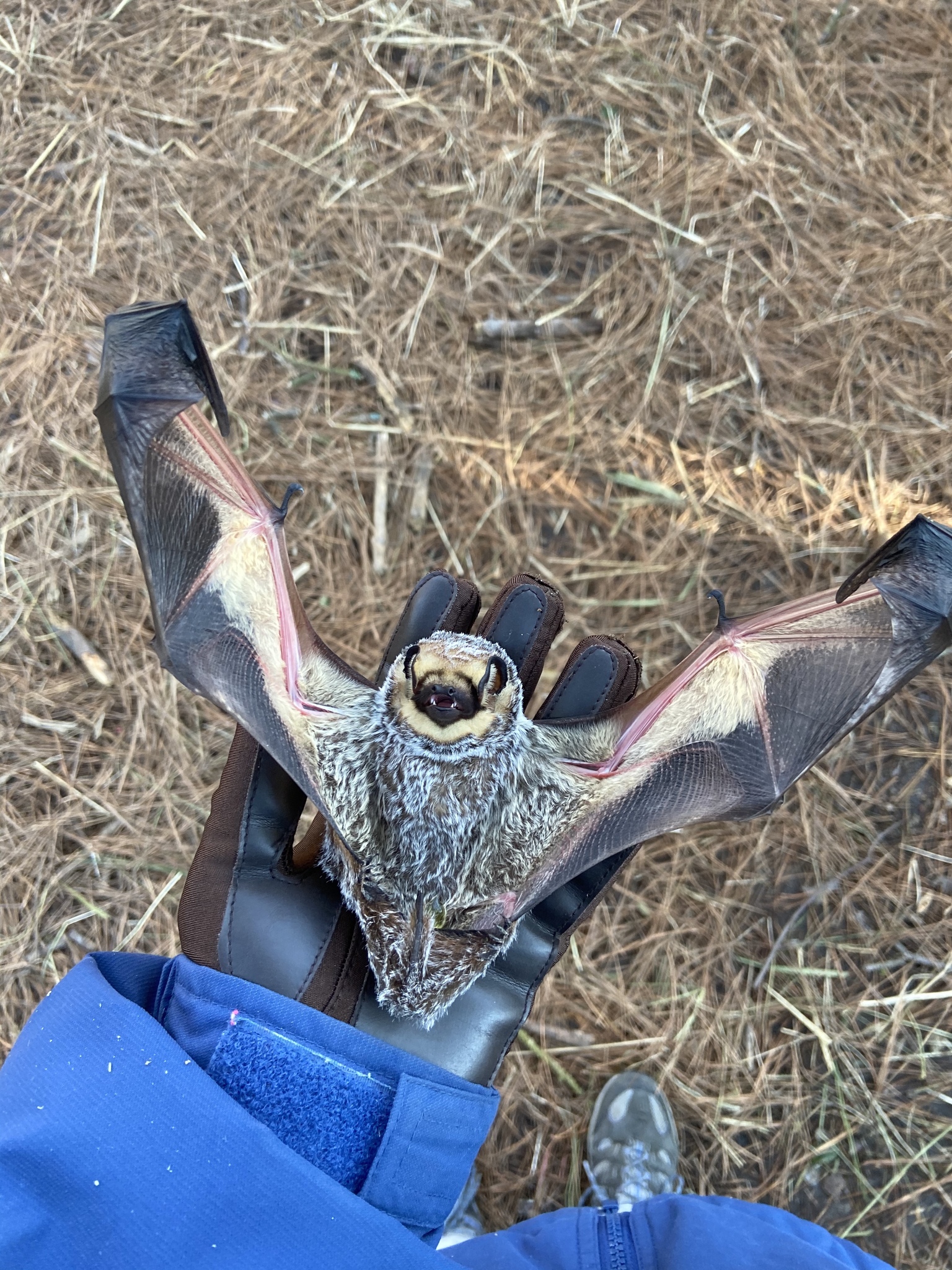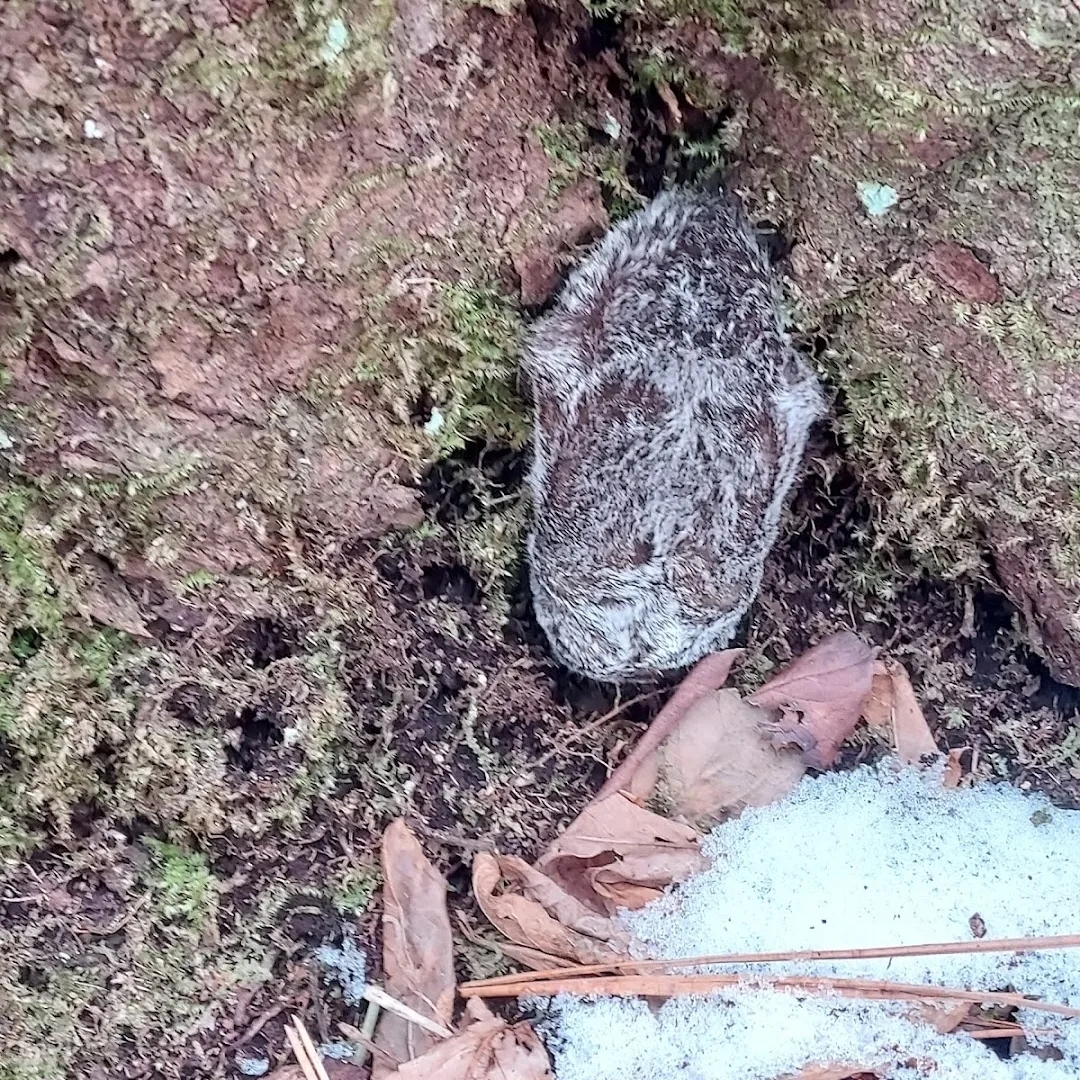Map Snapshot







10 Records
Status
The largest bat species in Maryland is one of our tree bat species. In summer they are solitary and often roost in coniferous trees near clearings. They typically migrate south for winter and hibernate in coniferous trees.
Relationships
Insectivorous. Roosts and hibernates in coniferous trees.
Seasonality Snapshot
Source: Wikipedia
| Hoary bat | |
|---|---|

| |
| Scientific classification | |
| Domain: | Eukaryota |
| Kingdom: | Animalia |
| Phylum: | Chordata |
| Class: | Mammalia |
| Order: | Chiroptera |
| Family: | Vespertilionidae |
| Genus: | Lasiurus |
| Species: | L. cinereus
|
| Binomial name | |
| Lasiurus cinereus (Beauvois, 1796)
| |

| |
| Distribution of the hoary bat (2008) | |
The hoary bat (Lasiurus cinereus)[2] is a species of bat in the vesper bat family, Vespertilionidae. It lives throughout most of North America (and possibly also in Hawaii, although this is disputed).
Taxonomy
[edit]The hoary bat was described as a new species in 1796 by Palisot de Beauvois. Beauvois noted that the holotype was collected in the US state of Pennsylvania by an individual identified as "Master Pancake".[3] It has many taxonomic synonyms, including Vespertilio pruinosis (Say, 1823) and Atalpha mexicana (Saussure, 1861). Mammalogist Harrison Allen was the first to use its current name combination of Lasiurus cinereus, doing so in 1864.[4] In a later publication, Allen placed it in the now-defunct genus Atalapha, with a scientific name of Atalpha cinerea.[5]
The South American hoary bat (L. villosissimus), which is found throughout South America, and the Hawaiian hoary bat (L. semotus), which is endemic to Hawaii, were both previously classified under the hoary bat, but phylogenetic evidence supports them being distinct species.[6]
Some have argued to elevate the subgenus (Aeorestes) to a genus level classification for L. cinereus. However, this has not been accepted by taxonomic authorities as it violates the International Code of Zoologigal Nomenclature[7][8]
Distribution
[edit]It ranges throughout North America, from northern Canada south to Guatemala. Although the Hawaiian subspecies L. semotus was reclassified into a distinct species, studies in 2015 and 2017 found evidence supporting two different colonization events of Hawaii by Lasiurus species; one about 1.4 million years ago by the ancestors of L. semotus, but also a much more recent colonization by true L. cinereus. This would mean that L. cinereus also inhabits the Hawaiian islands, in cryptic sympatry with L. semotus.[6][9] However, in contrast, a 2020 genetic study found no evidence of multiple bat species on Hawaii, finding the islands to only be inhabited by a single species, L. semotus, and attributed the previous results as a consequence of incomplete lineage sorting.[10]
Description
[edit]
The hoary bat averages 13 to 14.5 cm (5.1 to 5.7 in) long with a 40 cm (15.5 in) wingspan and a weight of 26 g (0.92 oz). It is the largest bat normally found in Canada. Its coat is dense and dark brown, with white tips to the hairs that give the species its 'hoary' appearance for which it is named.[11] The body is covered in fur except for the undersides of the wings. Males and females are dimorphic in body mass, with females 40% heavier than males.[12]
Behavior
[edit]The bat normally roosts alone on trees, hidden in the foliage, but on occasion has been seen in caves with other bats. It prefers woodland, mainly coniferous forests, but hunts over open areas or lakes. It hunts alone and its main food source is moths. The bats can cover an impressive 39 km (24 mi) while foraging.[11] Hoary bats are long-distance migrants, spending the winter in Central America and the southwestern United States and the spring and summer in more northern latitudes in the United States and Canada.[13]
Reproduction
[edit]The reproductive cycle of the hoary bat is not yet fully documented, but it is thought that they mate in August with birth occurring in June of the following year. It is thought that the gestation period is only 40 days and that mammalian embryonic diapause (delayed implantation) may play a role. Females typically bear twins, though litter sizes range from 1–4.[14] Young are typically weaned after 7 weeks.[15]
Conservation
[edit]While not listed as threatened or endangered, hoary bats suffer significant mortality from wind turbines. Across the United States in 2005, 40% of all bats killed by wind turbines were hoary bats—over 1000 hoary bats were killed in 2005.[16] Most bat deaths occur during migration in the spring and fall.[17] One common theory explaining this is that bats are attracted to the tall structure, possibly believing them to be trees that can be used for rest.[18]
See also
[edit]References
[edit]- ^ Gonzalez, E.; Barquez, R.; Arroyo-Cabrales, J. (2016). "Lasiurus cinereus". IUCN Red List of Threatened Species. 2016: e.T11345A22120305. doi:10.2305/IUCN.UK.2016-1.RLTS.T11345A22120305.en. Retrieved 19 November 2021.
- ^ Simmons, Nancy; Cirranello, A.L. (2020). "Bat Species of the World: A taxonomic and geographic database". Bats of the World A Taxonomic and Geographic Database. Retrieved 20 October 2021.
- ^ Peale, C.W. (1796). A Scientific and Descriptive Catalogue of Peale's Museum. Samuel H. Smith. p. 15.
- ^ Shump Jr., Karl A.; Shump, Anna U. (1982). "Lasiurus cinereus". Mammalian Species. 185. doi:10.2307/3503843. JSTOR 3503843.
- ^ Allen, H. (1893). A monograph of the bats of North America (No. 43). US Government Printing Office.
- ^ a b Baird, Amy B.; Braun, Janet K.; Mares, Michael A.; Morales, Juan Carlos; Patton, John C.; Tran, Christina Q.; Bickham, John W. (24 September 2015). "Molecular systematic revision of tree bats (Lasiurini): doubling the native mammals of the Hawaiian Islands". Journal of Mammalogy. 96 (6): 1255–1274. doi:10.1093/jmammal/gyv135. ISSN 0022-2372.
- ^ Ziegler, Alan C.; Howarth, Francis G.; Simmons, Nancy B. (March 2016). "A Second Endemic Land Mammal for the Hawaiian Islands: A New Genus and Species of Fossil Bat (Chiroptera: Vespertilionidae)". American Museum Novitates (3854): 1–52. doi:10.1206/3854.1. ISSN 0003-0082. S2CID 56234957.
- ^ Novaes, Roberto Leonan M.; Garbino, Guilherme S. T.; Cláudio, Vinícius C.; Moratelli, Ricardo (15 February 2018). "Separation of monophyletic groups into distinct genera should consider phenotypic discontinuities: the case of Lasiurini (Chiroptera: Vespertilionidae)". Zootaxa. 4379 (3): 439–440. doi:10.11646/zootaxa.4379.3.8. ISSN 1175-5334. PMID 29689956.
- ^ Baird, Amy B.; Braun, Janet K.; Engstrom, Mark D.; Holbert, Ashlyn C.; Huerta, Maritza G.; Lim, Burton K.; Mares, Michael A.; Patton, John C.; Bickham, John W. (11 October 2017). "Nuclear and mtDNA phylogenetic analyses clarify the evolutionary history of two species of native Hawaiian bats and the taxonomy of Lasiurini (Mammalia: Chiroptera)". PLOS ONE. 12 (10): e0186085. Bibcode:2017PLoSO..1286085B. doi:10.1371/journal.pone.0186085. ISSN 1932-6203. PMC 5636129. PMID 29020097.
- ^ Pinzari, Corinna A; Kang, Lin; Michalak, Pawel; Jermiin, Lars S; Price, Donald K; Bonaccorso, Frank J (27 August 2020). "Analysis of Genomic Sequence Data Reveals the Origin and Evolutionary Separation of Hawaiian Hoary Bat Populations". Genome Biology and Evolution. 12 (9): 1504–1514. doi:10.1093/gbe/evaa137. ISSN 1759-6653. PMC 7543519. PMID 32853363.
- ^ a b "Hoary bat videos, photos and facts - Lasiurus cinereus". ARKive. Archived from the original on 5 May 2016. Retrieved 22 May 2016.
- ^ Shump, Karl A.; Shump, Ann U. (1982). "Lasiurus borealis". Mammalian Species (183): 1–6. doi:10.2307/3503843. JSTOR 3503843.
- ^ Cryan, P. M.; Wolf, B. O. (2003). "Sex differences in the thermoregulation and evaporative water loss of a heterothermic bat, Lasiurus cinereus, during its spring migration". Journal of Experimental Biology. 206 (19): 3381–3390. doi:10.1242/jeb.00574. PMID 12939370.
- ^ Shump, Jr., K. A.; Shump, A. U. (1982). "Lasiurus cinereus". Mammalian Species. 85 (185): 1–5. doi:10.2307/3503878. JSTOR 3503878.
- ^ Koehler, C. E.; Barclay, R. M. R. (2000). "Post-Natal Growth and Breeding Biology of the Hoary Bat (Lasiurus Cinereus)". Journal of Mammalogy. 81 (1): 234–244. doi:10.1644/1545-1542(2000)081<0234:PNGABB>2.0.CO;2.
- ^ Kunz, Thomas H.; Arnett, Edward B.; Erickson, Wallace P.; Hoar, Alexander R.; Johnson, Gregory D.; Larkin, Ronald P.; Strickland, M Dale; Thresher, Robert W.; Tuttle, Merlin D. (2007). "Ecological impacts of wind energy development on bats: Questions, research needs, and hypotheses". Frontiers in Ecology and the Environment. 5 (6): 315–324. doi:10.1890/1540-9295(2007)5[315:EIOWED]2.0.CO;2. ISSN 1540-9295.
- ^ Baerwald, E. F.; Patterson, W. P.; Barclay, R. M. R. (2014). "Origins and migratory patterns of bats killed by wind turbines in southern Alberta: Evidence from stable isotopes". Ecosphere. 5 (9): art118. doi:10.1890/ES13-00380.1.
- ^ Jameson, Joel W.; Willis, Craig K. R. (1 November 2014). "Activity of tree bats at anthropogenic tall structures: implications for mortality of bats at wind turbines". Animal Behaviour. 97: 145–152. doi:10.1016/j.anbehav.2014.09.003. ISSN 0003-3472. S2CID 21715313.
External links
[edit]- NatureServe Archived 26 September 2007 at the Wayback Machine
- Animal Diversity Web
 Media related to Lasiurus cinereus at Wikimedia Commons
Media related to Lasiurus cinereus at Wikimedia Commons Data related to Lasiurus cinereus at Wikispecies
Data related to Lasiurus cinereus at Wikispecies- Bat Conservation International Species Profile



